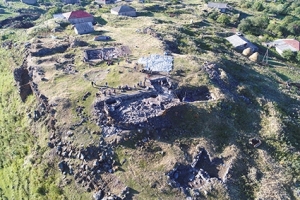New Bronze Age Archeological Finds Unearthed
This week, a team of international archaeologists led by the Georgian National Museum made a significant new discovery at the Rabati-Chobareti site in the village of Dzveli, in the Aspindza Municipality.
Dzveli (often transliterated as Zveli in international publications) and its neighboring village Chobareti are located in the south-central part of Georgia, near the border with Turkey. The area has been the site of archeological research for the last several years as part of a field school for Georgian archeology students, partners from the University of Melbourne, and researchers from France and the UK. The work is supported by the Shota Rustaveli National Science Foundation.
The latest discovery at the site is a group of what researchers are calling “powerful buildings” that date from the early Bronze Age, of a type and style “not [previously] found within the Caucasus region.”
The archeologists believe that they have uncovered burial sites and mounds, platforms or daises with carved figures of animals, and “other artifacts of ritual design,” that have “no analogues across the region,” explains a statement released by the Georgian National Museum. The find is thought to date back approximately 5000 years, to as early as the 30th century BC. For reference, around 3000 BC, it is believed that construction on Stonehenge in England began, and early agriculture took root in North Africa.
Scientists believe that the Rabati site was home to a significant, continuous settlement in the early Bronze Age, from around 3000 BC well into the Medieval period. Artifacts from later periods have also been unearthed, including clay animal figures and pottery circa 2000 BC, and figures thought to mark aristocracy, which have given researchers “an entirely new impression” about the area’s history and the ancient inhabitants of the land that would become Georgia.
The site, says the Georgian National Museum, opens a window into early human adaptation to the Caucasus environment and the development of societies from ancient history. The discoveries at the Rabati settlement contribute significantly to increasing awareness of Georgian archaeological sites in the scientific community, as well as better positioning the Georgian National Museum as a leading scientific institution on the world stage.
There are several publications from international scientific teams detailing the work done so far at the Rabati site in southern Georgia, including a 2013 paper (Kakhiani, et al.) that revealed the discovery of a Kura-Araxes settlement and burials, and a late Antique/Medieval stronghold. That paper also emphasizes the relative lack of excavation in the Samtskhe-Javakheti region, particularly compared to the neighboring Kvemo Kartli region, “boasting such prominent attractions as the hominid site of Dmanisi, the cluster of Neolithic settlements in the vicinity of Marneuli, and the rich barrow burials in the neighborhood of Trialeti.”
The team plans to continue working to carefully excavate the site and hopes to discover more specific details about the community that inhabited the Rabati site for centuries.
By Samantha Guthrie
Image source: Ministry of Education, Science, Culture, and Sport











